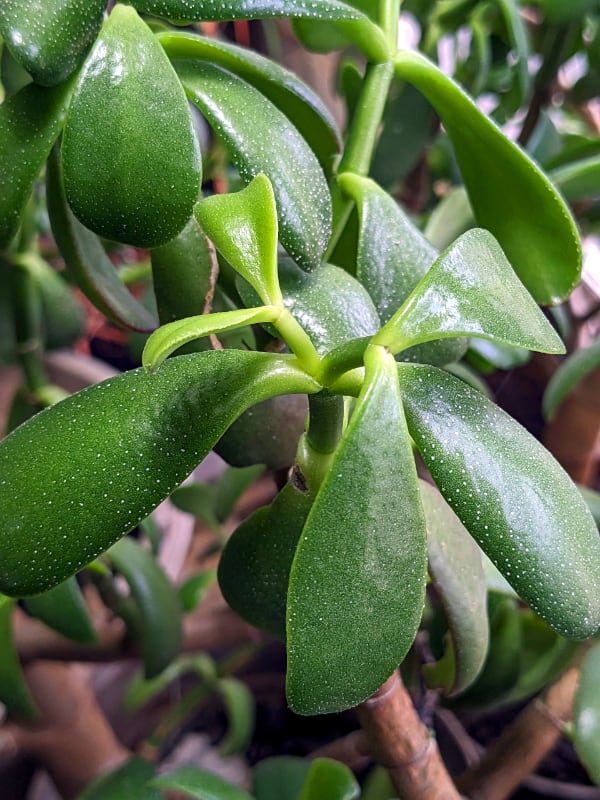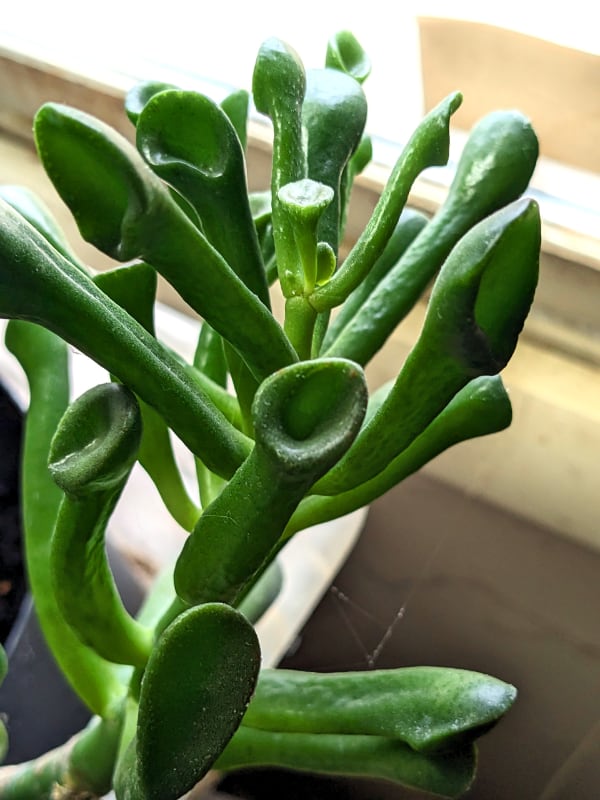
The moment of infestation is as clear as if it were this morning.
It was a gorgeous day in the spring of 1986 and I was walking on the south side of East 86th Street in New York City, toward its intersection with Third Avenue. The weather was sunny and warm, but not hot. As was common, street vendors had blankets spread on the sidewalk and from there they (probably illegally) sold their goods.
One of them sold houseplants, and one of the houseplants caught my eye. It was a nice jade plant, a main stem divided into a Y-shape three or four inches up. I thought it was attractive. How much? The vendor said it was $1.50. Seemed fair. (He tried to add sales tax, but I raised an eyebrow and gave him a dollar bill and two quarters. Transaction complete.) Remembering that $1.50 would be my undoing.
Within a few minutes the plant was installed happily in the southern window of my girlfriend’s apartment at 86th and Third. I watered it from time to time — she had no talent for plants, animals, or children, best I could tell. It grew slowly for the next 18 months until our jobs carried us in separate directions. I got custody of the jade plant.
There is a point to all this, and it will be toddling along in a bit.
When I was very young, there was a small jade plant in our dining room window. It didn’t ever get bigger, but it didn’t die, either. I have no idea what ultimately happened to it. For all I know, it’s still there, decades later.
Jade plants, Crassula ovata in polite company, come from South Africa where they are actually a ground cover. They don’t need much water; in fact, if they are over-watered they will quickly die. They are succulents, which are plants that store water in their leaves and stems. Like other succulents — cacti, aloe plants, a lot of strange-looking vegetation — they appear to have been designed by Dr. Seuss.

At home now, in my suburban apartment, I put the plant on my south-facing balcony, where it got more than enough sunlight. There it remained, and grew, through the summer. Though the jade plant’s root ball isn’t very big, it needed to be repotted before long, because it required a bigger base or its little pot would blow over in a slight breeze. Its leaves became darker green and a lot larger.
After a storm I noticed that a branch had fallen off. With nothing much in mind except that if I planted it and it grew I would have grown something worth $1.50, I stuck the branch into the now-available smaller pot. It took root quickly. And grew.
This kept happening. Every storm there would be little jade sprigs to plant. Soon I had a row of them on the balcony. They kept getting bigger.
Being mildly observant, I noticed that when the plants wanted to be watered, they would sprout little roots at joints along the stems. When a twig (for lack of a better word) broke off, it was always at one of these joints and there were always these tiny roots. Water the plant and the little roots dry up and fall off. Fail to water it and soon it will flower. The flowers are small, pinkish white, and not especially pretty. They look out of place — such a peculiar-looking plant shouldn’t have ordinary flowers, I think. I also learned that it is essential to rotate them, physically turn them a quarter turn every week or so. Like most plants, they grow toward the sun and get lop-sided in a hurry. This is more than an aesthetic issue with jade plants, because their stems and leaves are full of water so they are top-heavy. If one falls over, it will need to be re-potted and there will be a few more twigs to plant.
In the autumn I would bring them inside, and in spring they would go back out. Each transfer involved more plants than last time.
I began to give them away to anyone who would take one, or two, forgetting to charge $1.50 for them. Many homes in numerous states are to this day populated by jade plants descended — no, actually parts of — that original plant from East 86th Street.
Then came the autumn of 1993.
Through the kindly offices of a friend I was invited to travel to Kuwait to teach broadcast newswriting for a few weeks. In my excitement I forgot that winter was coming. Once there, though, I remembered, and phoned to ask a friend to bring in my plants. He said he would. He didn’t.
When I got home, the balcony looked like the scene of nuclear Armageddon.
Jade plants look sturdy, but it’s deceiving. Some of the plants had “trunks” the diameter of a tennis ball. They looked to be made of wood. But no, they are more like water balloons. They do not break, they collapse. What’s left is an empty structure resembling a honeycomb. The stumps were like something out of a science-fiction nightmare.
Oh, well, I thought, the $1.50 experiment is over.
I was wrong.
I kept on the balcony a lidded trashcan two-thirds full of potting soil, into which I’d deposit various plant debris and mix it in. It didn’t strictly compost, but it added, what, fiber to the diet of the plants I’d pot. A few days after I got home I thought I’d mix the jade plant remains into the potting soil. I took off the lid and there, on top, was a bit of green, almost too small to notice. It was a jade plant leaf that had fallen off and gotten swept up and dumped in the trashcan. It had sprouted an extremely tiny plant at its base. It wasn’t even as big as my pinkie fingernail.
I dug it out, planted it in a small pot, and took it indoors. By spring it was a nicely growing jade plant. By the following spring it was a half dozen plants, each bigger than the one I had bought nearly a decade earlier.
And so it went. When I moved, I brought them along. When I came to Ohio 19 years ago, I brought the ones I couldn’t give away. (And to make space in the truck I left behind things I could have used here, dammit.)
Soon I was giving them away to people here. I could see new friends crossing to the other side of the street as I approached. There may have been an informal network, people calling each other so they could lower the shades and lock the doors when I was in town.
My friend Skip, a plant lover, accepted a few. In return, he gave me a sprig of a “spoon jade” plant, and I was happy to have it. I’d never seen one before and have seen only a couple out in the world since. These are a different species, Crassula portulacea, and while they resemble the familiar jade plant in most ways they differ in the shape of their leaves, which are not broad and flat but long and cylindrical with a cup at the end. This presumably evolved to collect water, but the presumption is mine.

There are a dozen large spoon jades here now, too.
Everywhere you look in my house there are jade plants. The window sills are festooned with them. In the winter I put up a plastic shelf unit by the kitchen sliding door to hold the smaller ones. In the spring they all go back outside.
It is worth mentioning that jade plants are not actually good for anything. Houseplants are good indoors in the winter because they help keep up the humidity. But not jade plants, who hold on to their water. Nor can there be much gain from the moist dirt in the pots, because you mustn’t give them that much water or they will die. They are not good to eat and in fact may be mildly poisonous. (As with everything nowadays, there are people out there who say the jade plant can be used to formulate healthful remedies. Sure. They used to say radium tonic was good for you, too, and among my friends there are people who claim that marijuana is just the thing for what ails you.)
I’m hoping to find a self-help group for jade plant owners. They’ve taken over.
Besides, I have another project in mind. As I’ve mentioned numerous times, we are beset with Asian ladybugs and (Asian) marmorated stink bugs.
I’ve seen on TwitteX some people who happily raise carnivorous plants — pitcher plants, Venus flytraps, and so on. These catch and eat bugs. Just what I need. Imagine: a houseplant that pays its way.
There are questions I need to address, though. The first is whether the plant vendor is still on East 86th Street. The second is how much $1.50 will get me now.

Dennis E. Powell is crackpot-at-large at Open for Business. Powell was a reporter in New York and elsewhere before moving to Ohio, where he has (mostly) recovered. You can reach him at dep@drippingwithirony.com.
You need to be logged in if you wish to comment on this article. Sign in or sign up here.
Start the Conversation